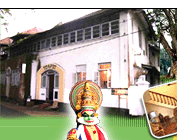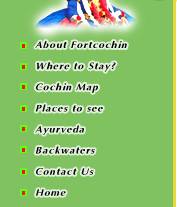|
|
Mattancherry
With
high-rise development restricted to Ernakulam, across the
water, the old fashioned character of Mattancherry and near
by Fort Cochin remains intact. Within an area small enough
to cover on foot,bycle or auto-rickshaw, glimpses of Kochi's
variegated history greet you at virtually every turn. As you
approach by ferry (get off at Mattancherry), the shoreline
is crowded with tiled buildings painted in pastel colors ,
a view that can't have changed for centuries.
Despite
the large number of tourists visiting daily, trade is still
the most important activity here. Many of the streets are
busy with barrows loaded with sacks of produce trundling between
godowns (warehouses) and little shops where dealers to business
in tea, jute, rubber, chillies, turmmeric,cashew,ginger,cardamom
and pepper.
|
|
Jew
Town
The
road heading left from Mattacherry Jetty leads into the district
known as Jew Town, where N.X.Jacob"s tailor shop and
the offices of J.E.Cohen, advocate and tax consultant,serve
as reminders of a once-thriving community. Nowadays many of
the shops sell antiques, Hindu and Christian woodcarvings,
oil
lamps,wooden jwellery boxes and other bric-a-brac.
Turning
right at the India Pepper & Spice Trade Building, usually
resounding with the racket of dealers shouting the latest spice
prices, and then right again, brings you into synagogue Lane.
The pardesi (White Jew) Synagogue (daily except Sat 10am-noon
& 3-5pm) was founded in 1568,and rebuilt in 1664. Its
interior is an attractive, if incongruous, hotchpotch; note
the floor, paved with hand-painted eighteenth- century blue-and-white
tiles from Canton, each unique, depicting a love affair between
a mandarin's daughter and a commoner. The nineteenth-century
glass oil-burning chandeliers suspended form the ceiling were
imported
from Belgium. Above the entrance, a gallery supported by
slender
gilt columns was reserved for female members of the congregation.
Opposite the entrance, an elaborately carved Ark houses four
scrolls of the Torah (the first five books of the Old Testament)
encased in silver and gold, on which are placed gold crowns
presented by the maharajas of Travancore and Cochin,
testifying
to good relations with the Jewish Community. The synagogue's
oldest artifact is a fourth-century copper plate inscription
fro the Raja of Cochin.
An
attendant is usually available to show visitor's around,
and answer questions; his introductory talk features as part
of the KTDC guided tour. Outside, in a small square, several
antique shops are well worth a browse, but don't expect a bargain.
|
|
Mattancherry Palace
Mattancherry
[palace (daily except friday 10am-5pm) stands on the left
side of the road a short walk from the Mattancherry Jetty
in the opposite direction to Jew Town. The gate way on the
road is, infact,its back entrance and it remains inexplicably
locked. I the walled grounds behind the gate stands a
circular, tiled Krishna Temple closed to non-Hindus).
Although
known locally as the Dutch Palace, the two-storey palace
was built by the Portuguese as a gift to the Cochin raja,Vira
Keralavarma(1537-61), and the Dutch were responsible for subsequent
additions. While its appearance is not particularly
striking, squat
with whitewashed walls and tiled roof, the interior is
captivating. The
murals that adorn some of its rooms are among the finest examples
of Kerala's much underrated school of painting; friezes illustrating
stories from the Ramayana. On the first floor, date from the
sixteenth century. Packed with detail and gloriously rich
colour, the style is never strictly naturalistic; the treatment
of facial features is pared down to the simplest of lines
for the mouths, and characteristically
aquiline noses. Downstairs, the women's bed chamber holds
several less complex paintings, possibly dating from the 1700s.
One shows Shiva dallying with Vishnu, who has assumed a female
form as the enchantress Mohini, a second portrays Krishna
holding aloft Mount Govardhana,another features a reclining
Krishna surrounded by gopis, or cow girls. His languid pose
belies the activity of his six hands and two feet,
intimately
caressing adoring admirers.
|
|







